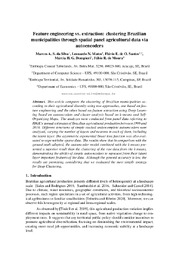Feature engineering vs. extraction: clustering Brazilian municipalities through spatial panel agricultural data via autoencoders.
Feature engineering vs. extraction: clustering Brazilian municipalities through spatial panel agricultural data via autoencoders.
Author(s): SILVA, M. A. S. da; MATOS, L. N.; SANTOS, F. E. de O.; DOMPIERI, M. H. G.; MOURA, F. R. de
Summary: This article compares the clustering of Brazilian municipalities according to their agricultural diversity using two approaches, one based on feature engineering and the other based on feature extraction using Deep Learning based on autoencoders and cluster analysis based on k-means and Self-Organizing Maps. The analyzes were conducted from panel data referring to IBGE?s annual estimates of Brazilian agricultural production between 1999 and 2018. Different structures of simple stacked undercomplete autoencoders were analyzed, varying the number of layers and neurons in each of them, including the latent layer. The asymmetric exponential linear loss function was also evaluated to cope with the sparse data. The results show that in comparison with the ground truth adopted, the autoencoder model combined with the k-means presented a superior result than the clustering of the raw data from the k-means, demonstrating the ability of simple autoencoders to represent from their latent layer important features of the data. Although the general accuracy is low, the results are promising, considering that we evaluated the most simple strategy for Deep Clustering.
Publication year: 2022
Types of publication: Paper in annals and proceedings
Observation
Some of Embrapa's publications are published as ePub files. To read them, use or download one of the following free software options to your computer or mobile device. Android: Google Play Books; IOS: iBooks; Windows and Linux: Calibre.
Access other publications
Access the Agricultural Research Database (BDPA) to consult Embrapa's full library collection and records.
Visit Embrapa Bookstore to purchase books and other publications sold by Embrapa.

